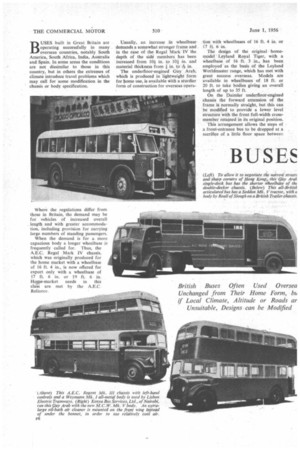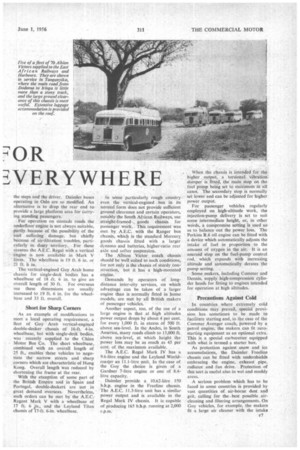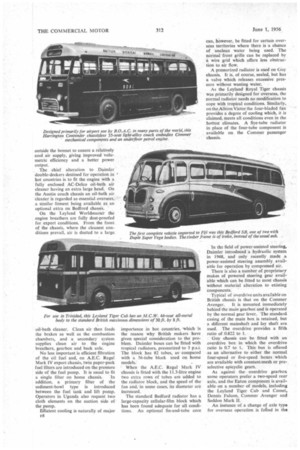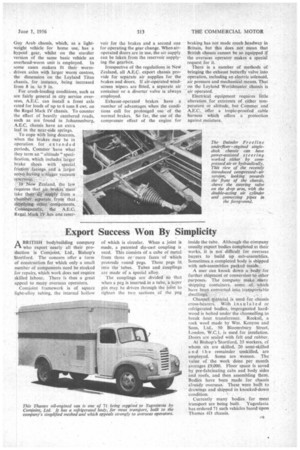BUSES OR F.JVERYWHERE
Page 104

Page 105

Page 106

Page 107

If you've noticed an error in this article please click here to report it so we can fix it.
BUSES built in Great Britain are operating successfully in many overseas countries, notably South America, South Africa, India, Australia and Spain. In some areas the conditions are not dissimilar to those in this country, but in others the extremes of climate introduce travel problems which may call for some modification in the chassis or body specification.
Where the regulations differ from those in Britain, the demand may be for vehicles of increased overall . length and with greater accommodation, including provision for carrying large numbers of standing passengers.
When the demand is for a more capacious body a longer wheelbase is frequently called for. Thus, the A.E.C. Regal Mark IV chassis, which was originally produced for the home market with a wheelbase of 16 ft. 4 in., is now offered for export only with a wheelbase of 17 ft. 6 in. or 19 ft. 6 in. Hoge-market needs in this class are met by the A.E.0 Reliance. Usually, an increase in wheelbase, demands a somewhat stronger frame and . in the case of the Regal Mark IV the depth of the side members has been increased from 101 in. to 101 in. and material thickness from I in. to 766 in.
The underfloor-engined Guy Arab, which is produced in lightweight form for home use, is available with a sturdier form of construction for overseas opera tion with wheelbases of 16 ft. 4 in. or .17 ft. 6 in.
The design of the original homemodel Leyland Royal Tiger, with a wheelbase of 16 ft. 3 in., has been employed as the basis of the Leyland Worldmaster range, which has met with great success overseas. Models are available in wheelbases of la ft. or 20 ft. to take bodies giving an overall length of up to 35 ft.
On the Daimler underfloor-engined chassis the forward extension of the frame is normally straight, but this can be modified to provide a lower level structure With the front full-width crossmember retained in its original position.
This arrangement allows the steps of a front-entrance bus to be dropped at a sacrifice of a little floor space between
the steps and the driver. Daimler buses operating in Oslo are so modified. An alternative is to drop the rear end to provide a large platform area for tarrying standing passengers.
For operation on unmade roads the underfloor engine is not always suitable, partly because of the possibility of the unit suffering damage, but chiefly because of air-filtrationtroubles, particularly in dusty territory. For these reasons the A.E.C. Regal with a vertical engine is now available in -Mark V form. The wheelbase is 19 ft. 6 in. or
21 ft. in. • The vertical-engined Guy Arab home chassis for single-deck bodies has a wheelbase of 18 .ft. 6 in. to give an overall length of 30 ft. For overseas use these dimensions are usually increased to 19 ft. 6 in. for the wheelbase and 33 ft. overall.
Short for Sharp Corners As an example of modifications to meet a local operating requirement, a fleet of Guy Arab vertical-engined double-decker chassis of 16-ft. 4-in. wheelbase, but with single-deck bodies. was recently supplied to the China Motor Bus Co. The short wheelbase, combined with an overall length of 25 ft., enables these vehicles to negotiate the narrow streets and sharp corners which are characteristic of Hong Kong. Overall length was reduced by shortening the frame at the rear.
With the exception of some part of the British Empire and in Spain and Portugal, double-deckeri arc not in great demand overseas. Nevertheless, such orders can be met by the A.E.C. Regent Mark V with a wheelbase of 17 ft. 6 an., and the Leyland Titan chassis of 17-ft. 6-in. wheelbase. In some particularly rough country even the vertical-engined bus in its normal form does not provide sufficient ground clearance and certain operators, notably the South African Railways, use straight-framed goods chassis for passenger work. This requirement was met by A.E.C. with the Ranger bus chassis, which is the standard Mercury goods chassis fitted with a larger dynamo and batteries, higher-ratio rear axle and softer suspension.
The Albion Victor coach chassis should be well suited to such conditions, for not only is the chassis of sturdy construction, but it has a high-mounted engine.
Demands by operators of longdistance inter-city services, on which advantage can be taken of a larger engine than is normally fitted in home models, are met by all British makers of passenger vehicles.
Another aspect, too, of the use of a large engine is that at high altitudes power output drops by about 4 per cent. for every 1,000 ft. in excess of 500 ft. above sea-level. In the Andes, in South America, many roads climb to 15,000 ft. above sea-level, at which height the power loss may be as much as 45 per cent. of the maximum available.
The A.E.C. Regal Mark IV has a 9.6-litre engine and the Leyland Worldmaster an 11.1-litre unit._ In the case of the Guy the choice is given of a Gardner 7-litre engine or one of 8.4litre capacity.
Daimler provide a 10.62-litre 150 b.h.p. engine in the Freeline chassis. The A.E.C. 11.3-litre unit has a similar power output and is available in the Regal Mark IV chassis. It is capable of producing 165 b.h.p. running at 2,000 T.p.m. When the chassis is intended for the higher output, a torsional vibration damper is fitted, the main stop on the fuel pump being set to maximum in all cases. The secondary stop is normally set lower and can be adjusted for higher power output.
For passenger vehicles regularly employed on high-altitude work, the injection-pump delivery is set to suit some intermediate height, or, in other words, a compromise setting Is used so as to balance out the power loss. The Perkins R.6 oil engine can be fitted with a device which automatically adjusts the intake of fuel in proportion to the amount of oxygen in the air. It is an aneroid stop on the fuel-pump control rod, which expands with increasing altitude and automatically derates the pump setting.
Some makers, including Commer and Dennis, supply high-compression cylinder heads for fitting to engines intended for operation at high altitudes.
Precautions Against Cold
In countries where extremely cold conditions may prevail, special provision has sometimes to be made to facilitate starting and, in the case of the Commer Avenger coach, powered by a petrol engine, the makers can lit zerostarting equipment as an optional extra. This is a special carburetter equipped with what is termed a starter box.
As protection against snow and ice accumulations, the Daimler Freetine chassis can be fitted with undershields embracing the engine, exhaust pipe, radiator and fan drive. Protection of this sort is useful also in wet and muddy areas.
A serious problem which has to be faced hi some countries is provided by vast quantities of air-borne dust and grit, calling for the -best possible aircleaning and filtering arrangements. On Guy vehicles, for example, the makers fit a large air cleaner with the intake outside the bonnet to ensure a relatively cool air supply, giving improved volumetric efficiency and a better power output.
The chief alteration to Daimler double-deckers destined for operation in ' hot countries is to fit the engine with a fully enclosed AC-Delco oil-bath air cleaner having an extra large head. On the Austin coach chassis an oil-bath air cleaner is regarded as essential overseas, a similar fitment being available. as an optional extra on Bedford chassis.
On the Leyland Worldmaster the engine breathers are fully dust-proofed for export conditions. From the front of the chassis, where the cleanest conditions prevail, air is ducted to a large oil-bath cleaner. Clean air then feeds the brakes as well as the combustion chambers, and a secondary system supplies clean air to the engine breathers, gearbox and back axle.
No less important is efficient filtration of the oil fuel and, on A.E.C. Regal Mark IV export chassis, twin paper-pack fuel filters are introduced on the pressure side of the fuel pump. it is usual to fit a single filter on home chassis. In addition, a primary filter of the sediment-bowl type is introduced between the fuel tank and lift pump. Operators in Uganda also request two cloth elements on the suction side of the pump.
Efficient cooling is naturally of major F8
importance in hot countries, which 'is the reason why British makers have given special consideration to the problem. Daimler buses can be fitted with tropical radiators, pressurized to 3 p.s.i. The block has 82 tubes, ascompared with a 56-tube block used on home models.
When the A.E.C. Regal Mark 1V chassis is fitted with the 11.3-litre engine two extra rows of tubes are added to the radiator block, and the speed of the fan and; in some cases, its diameter are increased.
The standard Bedford radiator has a large-capacity cellular-film block which has been found adequate for all conditions. An optional fin-and-tube core
can, however, be fitted for certain overseas territories where there is a chance of unclean water being used. The normal front grille can be replaced by a wire grid which offers less obstruction to air flow.
A pressurized radiator is used on Guy chassis. It is, of course, sealed, but has a valve which releases excessive pressure without wasting water.
As the Leyland Royal Tiger chassis was primarily designed for overseas, the normal radiator needs no modification to cope with tropical conditions. Similarly, on theAlbion Victor the four-bladed fan provides a degree of cooling which, it is claimed, meets all conditions even in the hottest climates. A fiye-tube radiator in place of the four-tube component is available on the Commer passenger chassis.
In the field of power-assisted steering, Daimler introduced a hydraulic system in 1948, and only recently made a power-assisted steering assembly available for operation by compressed air.
There is also a number of proprietary makes of powered steering gear available which can be fitted to most chassis without material alteration to existing components.
Typical of overdrive units available on British chassis is that on the Commer Avenger. It is mounted immediately behind the main gearbox and is operated by the normal gear lever. The standard. casing of the main box is retained, but a different mainshaft and lay shaft are used. The overdrive provides a fifth ratio of 0.822 to I.
• Guy chassis can be fitted with an overdrive box in which the overdrive ratio is 0.7 to I. This box is offered as an alternative to either the normal four-speed or five-speed boxes which are available with constant-mesh or preselective epicyclic gears.
As against the overdrive gearbox some operators prefer a two-speed rear axle, and the Eaton component is available on a number of models, including the Leyland Tiger Cub and Comet, Dennis Falcon, Commer Avenger and Seddon Mark H.
Guy Arab chassis, which, as a lightweight vehicle for home use, has a hypoid gear, whilst on the sturdier version of the same basic vehicle an overhead-worm unit is employed. In some cases makers fit their wormdriven axles with larger worm centres, the dimension on the Leyland Titan chassis, for instance, being increased from 8 in. to 9 in.
For crush-loading conditions, such as are fairly general in city service overseas, A.E.C. can install a front axle rated for loads of up to 6 tons 8 cwt. on the Regal Mark IV chassis. To counter the effect of heavily cambered roads, such as are found in Johannesburg, A.E.0 chassis have an extra leaf in the near-side springs.
To cope with long descents, when the brakes may be in operation for extended periods, Commer have what they term an " altitude" specification, which includes larger brake shoes with "special friction facings-rand a larger servo having a...bigger .vacuum .
.r.eservoirL
In New Zealand,. the law , requires that air brakesemust' take their air supplyfrom a chamber .separate from that OpplyingOther coniponents... Consequently, the A.E.0 Regal. Mark IV has one. re.ser
voir for the brakes and a second one for operating the gear change. When airoperated doors arc in use, the air supply can be taken from the reservoir supplying the gearbox.
Irrespective of the regulations in New Zealand, all A.E.C. export chassis provide for separate air .supplies for the brakes and doors. If air-operated windscreen wipers are fitted, a separate air container or a diverter valve is always employed.
Exhaust-operated brakes have a number of advantages when the conditions call for prolonged use of the normal brakes. So far, the use of the compressor effect of the engine for braking has not made much headway in Britain, but this does not mean that British chassis cannot he so equipped if the overseas operator makes a special request for it.
There is a number of methods of bringing the exhaust butterfly valve into operation, including an electric solenoid, air pressure and mechanical means. That on the Leyland Worldmaster chassis is air operated.
Electrical equipment requires little alteration for extremes of either temperature or altitude, but Cornrrier and A.E.C. offer a tropic-proofed cable harness which offers a protection against moisture.
An instance of a change of axle type for overseas operation is fotInd in the




























































































































































































































































